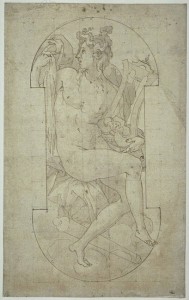For a fresco in the Salle Haute of the Pavillon des Poêles, Fontainebleau
1537 or 1538
Paris, Louvre, Inv. 8632.
Pen and grayish ink and wash; lightly squared in black chalk, 29.4 x 18.4. There are several lines in brown ink that seem to be additions to the original drawing: two lines defining the breasts, the line alongside the brow and nose, those on both sides of the left leg, and the line in back of the left hand; the drawing is very faded, especially the wash, somewhat stained, especially at the bottom, and spotted here and there at the top.
PROVENANCE: Desneux de la Noue (signature on verso, Lugt 3014); E. Jabach (paraph on verso, Lugt 2959). Entered the Royal French Collection in 1671.
LITERATURE:
Carroll, 1964 (1976), I, Bk. I, 252, II, Bk. II, 406-408, D.46 (COPY), Bk. III, Fig. 125, as a copy of a lost drawing by Rosso of c. 1534-1536 and as possibly made to flank the Education of Achilles in the Gallery of Francis I; “Addition to the Preface,” 1976, vii, as autograph.
Carroll, 1978, 48, n. 29, as Rosso, and for the Salle Haute at Fontainebleau.
Béguin, 1982, 30, 35, Fig. 12, 48, n. 32, as Rosso.
Carroll, 1987, 10, 11, 330-335, no. 104, Fig., as by Rosso for the Salle Haute at Fontainebleau, and done in 1537 or 1538.
Boorsch, 1988, 9, as “lifeless;” she thought that my original judgment that it is a copy may be correct.
Scailliérez, 1992, 134, no. 58, as Rosso, for the Pavillon des Poêles, and as showing Apollo holding a lyre in one hand and in the other the skin of his rival Marsyas.
The figure of Apollo resembles in his proportions, but even more in his pose, with his body and limbs arranged largely parallel to the picture plane, the figures of Europa and Philyra that flank the Royal Elephant in the Gallery of Francis I (Fig.P.22, VI N a). However, the figure of Apollo is somewhat more precisely composed within its frame, suggesting the composition of the nudes on either side of the Education of Achilles (Fig.P.22, II N a). It is true that these nudes represent an entirely different physical type, but they are posed in a broad and clear manner to fill their vertical settings, which are also rounded at the top and bottom, comparable to the way that Apollo is arranged within the area given to him. He is also similar to the foremost vase bearer in the Sacrifice in the gallery (Fig.P.22, VII N a), both figures having something of the same proportions, and almost identical profiles. Apollo’s hair is piled up rather like that of the twin at the far right in the Twins of Catania (Fig.P.22, V N a), a detail that is more clearly visible in the drawing, albeit a copy, related to this fresco (Fig.D.60). He is most similar, however, to the elongated and finely articulated figure of Christ in the Louvre Pietà (Fig.P.23a). The detail of showing Apollo holding the flayed skin of Marsyas is a poignant detail, which, along with the god’s anxious upward glance, also speaks for Rosso’s authorship.
Graphically, the Louvre drawing is very much like the Pandora and Her Box (Fig.D.67a) and the Throne of Solomon (Fig.D.34). The handling of the Apollo has not the spontaneity of the Pandora but also not the very studied appearance of the Aretine drawing. Fading and stains on the sheet lessen the effectiveness of the shadows on Apollo’s body. At the same time, however, the execution of so many parts of the drawing, especially the penmanship of the head and hair, and of the lyre, is so deft and sensitive as to indicate that the drawing is autograph and not a copy of a lost drawing by Rosso. This single figure has not a narrative context nor the revelatory light of the Pandora. I might add that there are innumerable copies of existing autograph drawings by Rosso, many of which I had not seen by 1964 when I judged this drawing a copy, and none show the deftness or the pentimenti of this drawing. Nor do any of these lifeless copies show the poignancy presented by Apollo’s expression and by the pentimenti of his profile as he examines the skin of Marsyas, whose horrible death was decreed by Apollo himself (see also Rosso’s earlier drawing, Fig.D.41a).
As the Apollo is most similar to the Louvre Pietà, probably done in 1538, it is likely that the drawing was done about the same time. It appears to have been made for the decoration of the Salle Haute (L.43) in the Pavillon des Poêles at Fontainebleau, to which can also be related a Venus and Cupid (Fig.E.152) and a Diana Shooting with Her Bow (Fig.E.61). The construction of this pavilion was probably begun in 1535, but it is likely that the decoration of the Salle Haute at the top of it was not commenced until after the Gallery of Francis I was largely completed. This would place the beginning of the decorative work in the Salle Haute probably no earlier than 1537 or even 1538. The Apollo could have been done in either year. Its style is not especially identifiable with that of works that appear to have been made in the last period of Rosso’s career.
Rosaline Bacou, in Collections de Louis XIV, 1977-1978, 74, under no. 34, pointed out that some of the drawings in the collection of Desneux de la Noue were gathered by him from the studios at Fontainebleau. The Apollo could have been one of them.
COPY, PRINT: Anonymous, E.151 (Fig.E.151). Engraving.
There is another print of this subject (Fig.E.60), which is not, however, based on the drawing in the Louvre.

